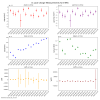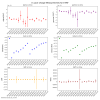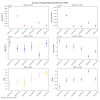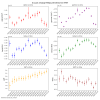TITLE: 11/07 Day Shift: 1530-0030 UTC (0730-1630 PST), all times posted in UTC
STATE of H1: Earthquake
OUTGOING OPERATOR: Ryan C
CURRENT ENVIRONMENT:
SEI_ENV state: USEISM
Wind: 10mph Gusts, 8mph 3min avg
Primary useism: 0.04 μm/s
Secondary useism: 0.75 μm/s
QUICK SUMMARY:
IFO is LOCKING at INITIAL_ALIGNMENT
We had a very local EQ during the no-call time on OWL (alog 88001) that tripped the following watchdogs: ISI EY ST1, ISI EY ST2, ISI IX ST1, ISI IX ST2, ISI IY ST1, ISI IY ST2, SUS IX, SUS IY, SUS EY, IX HW WD. IY HW WD, ISI HAM1, SEI ISI IX SW, SEI ISI IY SW, HEPI IX, HEPI IY.
Richard, who was on site, untripped them before shift start.
Just started an initial alignment and now watching out for SRY and IM issues that have happened before during violent WD tripping EQs.
Hoping for a smooth day of OBSERVING


































The MY PT243 Cold Cathode vacuum gauge still trying to fire back up. I have extended its alarm bypass. It is the reason for the red "CDS ALARM" indicator on the CDS Overview.
Bypass will expire:
Mon Nov 10 10:26:18 AM PST 2025
For channel(s):
H0:VAC-MY_Y1_PT243B_PRESS_TORR